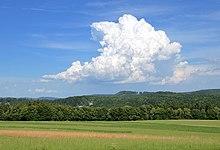| Cumulus mediocris cloud | |
|---|---|
 Cumulus mediocris clouds above Auckland with streaks of light precipitation visible in the distance. | |
| Abbreviation | Cu |
| Symbol | |
| Genus | Cumulus (heaped) |
| Species | mediocris (moderate) |
| Altitude | 500-3000 m (1,500-10,000 ft) |
| Appearance | Medium to large cumulus clouds |
| Precipitation cloud? | Uncommon, but it can develop into a cumulus congestus which is a common precipitation cloud |
Cumulus mediocris is a low to middle level cloud with some vertical extent (Family D1) of the genus cumulus, larger in vertical development than Cumulus humilis.[1] It also may exhibit small protuberances from the top and may show the cauliflower form characteristic of cumulus clouds. Cumulus mediocris clouds do not generally produce precipitation of more than very light intensity, but can further advance into clouds such as Cumulus congestus or Cumulonimbus, which do produce precipitation.
Cumulus mediocris is also classified as a low cloud and is coded CL2 by the World Meteorological Organization.[2]
Cumulus mediocris is brilliantly white when sunlit, and is dark underneath. A single pattern-based variety, Cumulus radiatus, is sometime seen when the individual clouds are arranged into parallel rows. The resulting formations are known as "cloud streets" and are aligned nearly parallel to the wind.[1]
Cumulus mediocris may have precipitation-based features like virga, and may form Cumulus praecipitato clouds.[3] The pannus supplementary feature is sometimes seen with precipitating Cumulus mediocris, but in this case the CL7 reporting code normally used with to identify pannus is usually superseded by CL2, since there is significant vertical development. Pileus (cap cloud), velum (apron), arcus (roll or shelf cloud) and tuba (vertical column) features are also occasionally seen with cumulus mediocris. Cumulus mediocris may form as a result of a partial transformation of altocumulus or stratocumulus. This genus and species type may also be the result of a complete transformation of stratocumulus or stratus.
Forecasting
These clouds are common in the advance of a cold front or in unstable atmospheric conditions such as an area of low pressure. They can grow into larger Cumulus congestus which could bring rain, winds and in worse cases, thunder and lightning. If these clouds are present in the morning or early afternoon they show a significant instability in the atmosphere likely leading to storms later in the day.
Formation
These clouds occur when there is more rising air than the Cumulus humilis. Like any cumulus cloud, this cloud requires convection before developing. This occurs when pockets of air around them become warmer and begin to rise. As the air rises, it condenses forming a Cumulus humilis cloud as it continues to rise, a Cumulus mediocris.[4]
See also
- Atmospheric convection
- Cumulus congestus
References
- ^ a b National Weather Service. "L2 Clouds: Cumulus (Cu) of moderate/strong development". JetStream. NOAA. Retrieved 2018-06-10.
- ^ "Meteorological Codes". Retrieved 2018-06-10.
- ^ "Cumulus praecipitatio". namesofclouds.com. Retrieved 10 June 2018.
- ^ "Mediocris_Clouds_Wolstaton". Archived from the original on 2014-11-04. Retrieved 2014-11-04.

